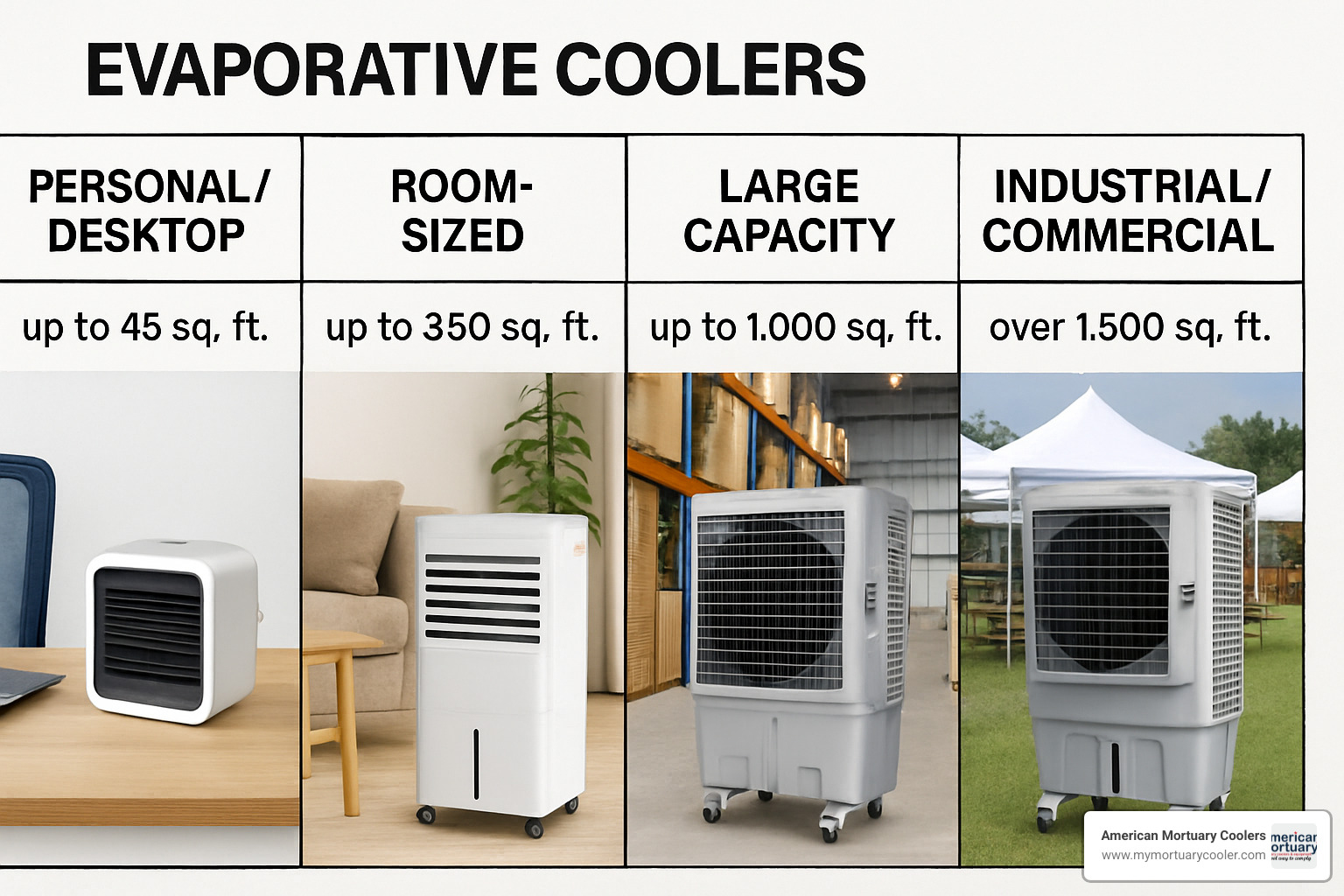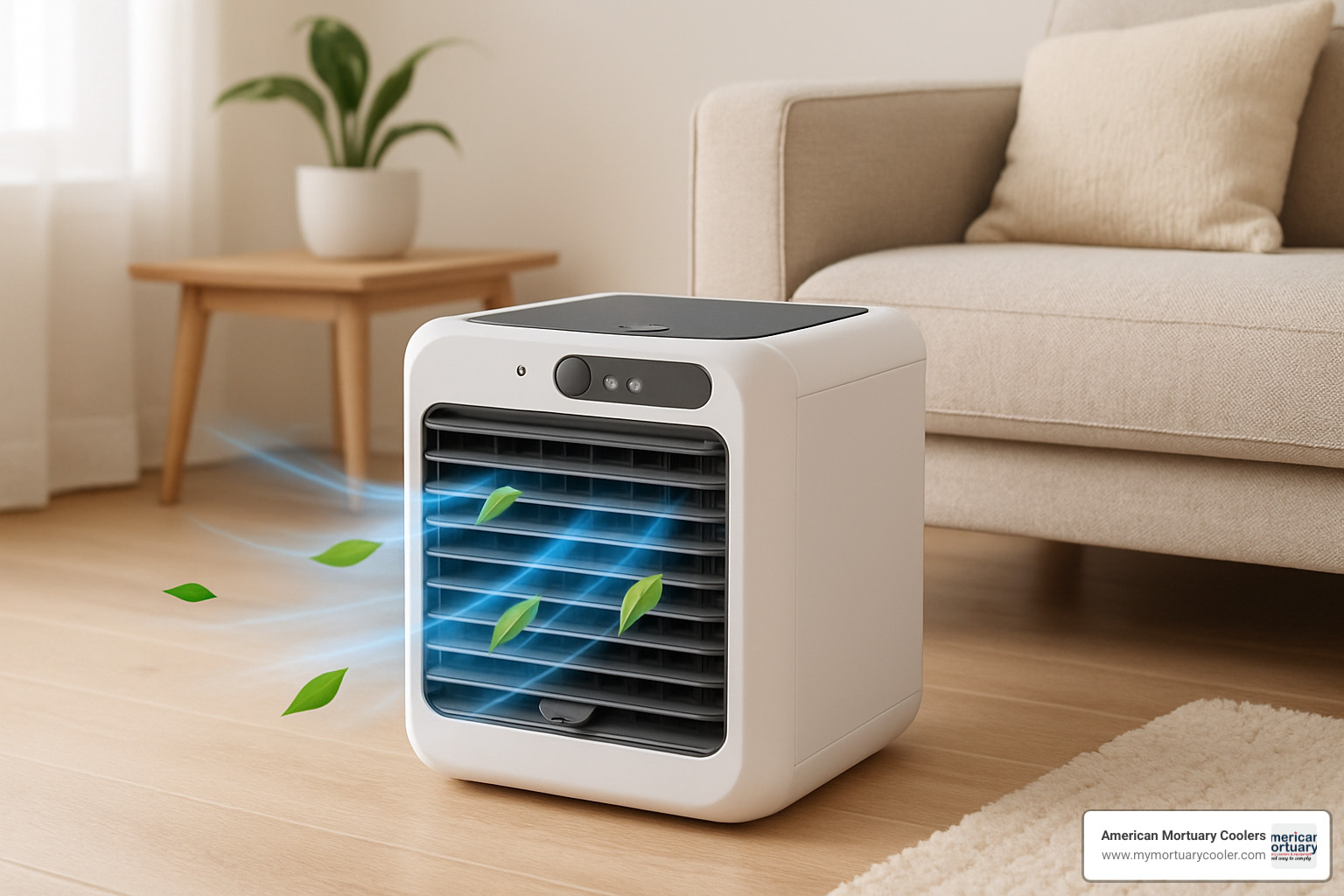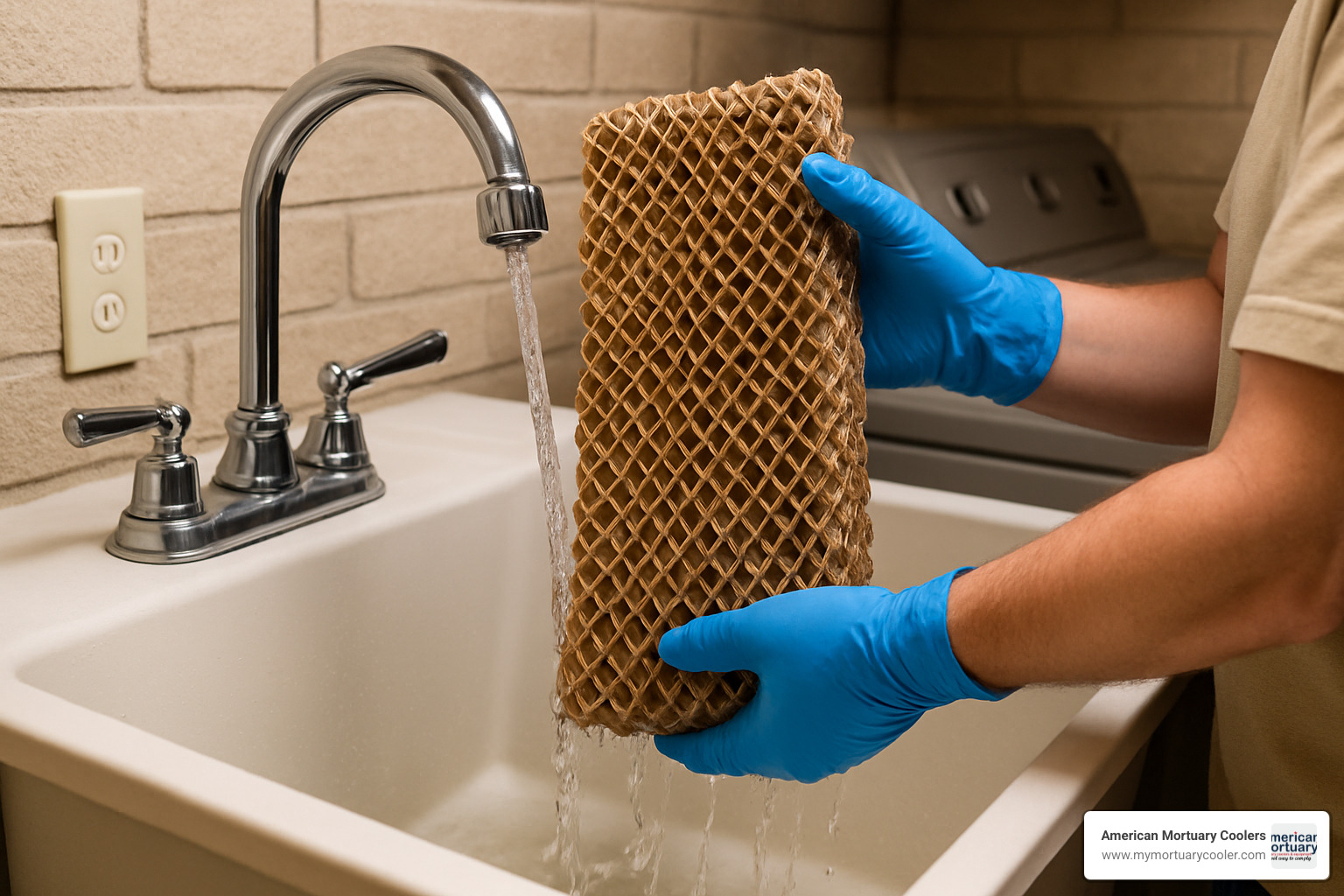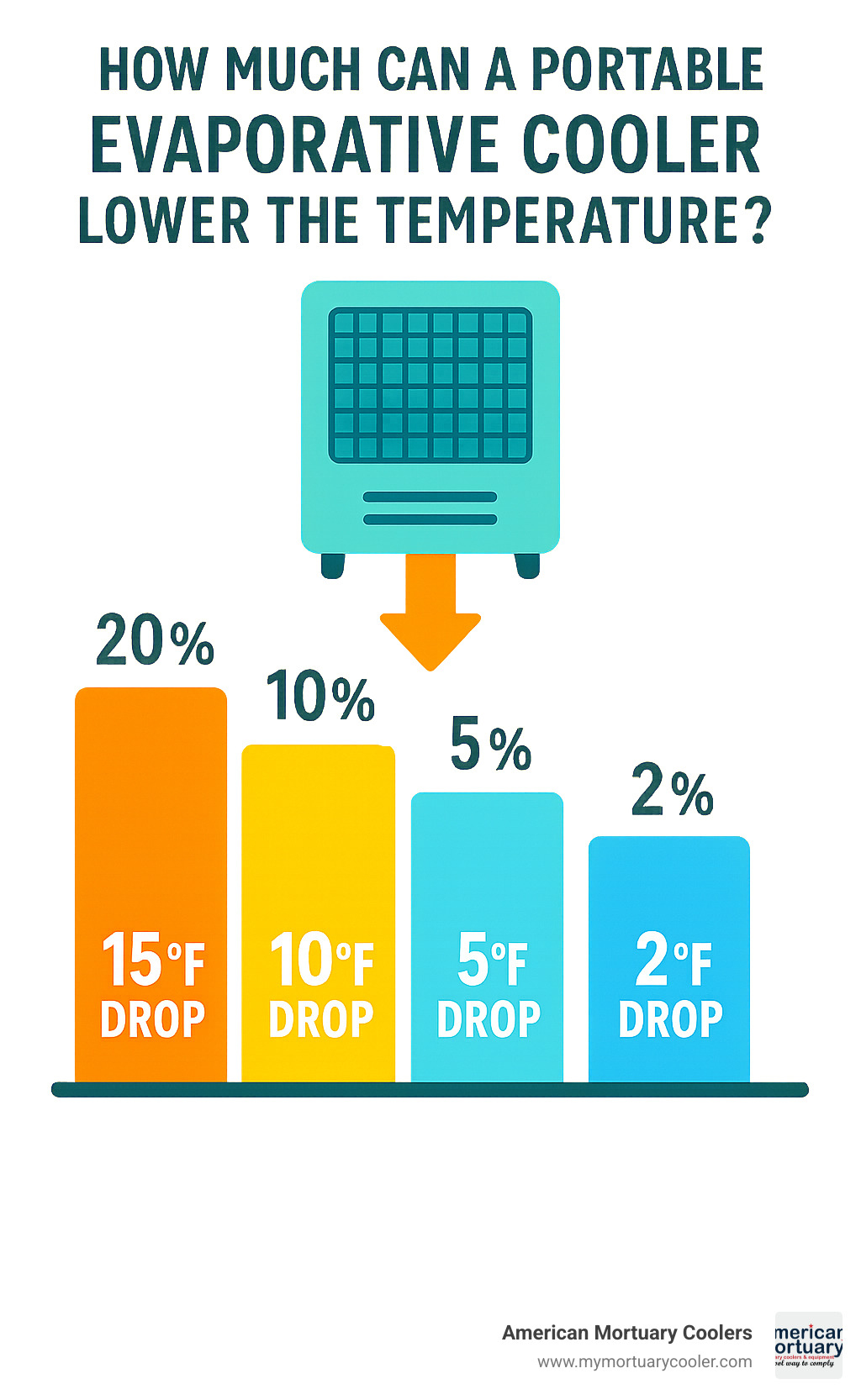Why Portable Evaporative Coolers Are the Smart Choice for Energy-Efficient Cooling
A portable evaporative cooler is a mobile cooling device that uses water evaporation to lower air temperature, offering an eco-friendly alternative to traditional air conditioners. Here's what you need to know:
Key Benefits:
- Energy Efficient: Uses only 32-300 watts vs 1,000+ watts for AC units
- Cost Effective: Operates for about the same cost as two 100W light bulbs
- Eco-Friendly: No refrigerants or chemicals required
- Portable: Easy to move between rooms with wheels and handles
- Dual Function: Cools and humidifies simultaneously
Best For:
- Hot, dry climates with ≤60% humidity
- Spaces from 33 sq ft (desk area) to 3,000+ sq ft (warehouses)
- Indoor and outdoor use with proper ventilation
When summer heat becomes unbearable and energy bills skyrocket, portable evaporative coolers can drop temperatures by up to 15°F while consuming significantly less electricity than air conditioners. These units work by mimicking nature's cooling system - just like how perspiration cools your body through evaporation.
The effectiveness depends heavily on your local climate and humidity levels. Unlike traditional AC systems that use energy-hungry compressors and chemical refrigerants, evaporative coolers simply use a fan, water pump, and natural evaporation to create comfortable temperatures.

How Portable Evaporative Coolers Work & When to Use Them
A portable evaporative cooler works like the natural cooling you feel when a breeze hits your sweaty skin. When water evaporates, it pulls heat from surrounding air.
The process is simple: A pump moves water from the reservoir to honeycomb cooling pads, which get completely soaked. The fan pulls hot, dry air through these wet pads. As air passes through, water evaporates and removes heat, producing cool, slightly humid air.
The magic works best when relative humidity stays at 60% or lower. In these conditions, expect temperature drops of up to 15°F. So if it's 95°F outside with dry air, your cooler could bring your area down to 80°F.
Unlike air conditioners that seal everything up, evaporative coolers need cross-ventilation. Crack open a window or door for best results - the fresh air coming in and humid air going out actually strengthens the cooling effect.
For detailed guidance, check out our An Essential Guide to Comparing Evaporative Portable Air Coolers and this Scientific research on evaporative cooling.
Portable Evaporative Cooler vs Traditional Air Conditioner
The difference is like comparing a bicycle to a motorcycle - both work, but one is far more complex and expensive to operate.
Traditional air conditioners use compressors, chemical refrigerants, and complex cycles that demand serious electricity. A portable evaporative cooler is refreshingly simple - just a fan, pump, and water doing what it does naturally.
The energy numbers tell the story. While portable AC units consume 1,000 to 3,000+ watts, a portable evaporative cooler uses just 32 to 300 watts - roughly the same as two 100-watt light bulbs.
Evaporative coolers are completely freon-free and don't use chemical refrigerants that harm the ozone layer. Instead of removing moisture like AC units, they add beneficial humidity - perfect for dry climates.
However, air conditioners work anywhere and hit exact temperatures. They're better in humid climates or when you need precise control. Portable evaporative coolers are climate-dependent and add moisture to your space.
For help deciding which fits your situation, see our Ultimate Checklist for Choosing the Best Portable Air Cooler.
Ideal Climates for a Portable Evaporative Cooler
If you live in the desert Southwest - Arizona, Nevada, parts of California, or similar hot, dry areas - you've hit the portable evaporative cooler jackpot. These regions offer perfect conditions of high temperatures and low humidity.
The key number is 60% relative humidity. Stay below this and your cooler performs beautifully. Between 60-70% humidity, you'll get decent cooling during drier parts of the day. Above 70% humidity, consider traditional air conditioning.
Even in less dry areas, evaporative coolers excel in specific situations. Outdoor patios and decks work perfectly since moisture drifts away naturally. Workshops, garages, and semi-enclosed spaces also work great without extending your home's AC system.
Indoor spaces work well with good ventilation. Plan to crack open a window or door about 1-2 inches for every 100 CFM of cooler capacity.
For optimal operating conditions, see Evapolar working conditions.
Choosing the Right Portable Evaporative Cooler for Your Space
Finding the perfect portable evaporative cooler comes down to understanding airflow - specifically, how many cubic feet per minute (CFM) you need.
The golden rule: you need about 2 CFM for every square foot you want to cool. For a 200-square-foot bedroom, you'll want at least 400 CFM. Size up a bit to account for real-world conditions.
Personal coolers with 200-500 CFM work for desk areas and spaces up to 250 square feet.
Small room units with 1,000-2,000 CFM handle 500-1,000 square feet - living rooms, bedrooms, or home offices.
Large capacity models with 3,000-5,000 CFM tackle bigger challenges up to 2,500 square feet.
For industrial applications, units with 10,000+ CFM cool 5,000+ square feet.
Tank size matters. Compact 1-2 liter tanks need refilling every 4-8 hours. Larger 10-40 liter tanks run all day. Some connect to garden hoses for continuous operation.
Quality units max out around 60 decibels - about as loud as normal conversation. Look for multiple speed settings to balance cooling power and quiet operation.
Portability features matter. Desktop units (5-15 pounds) move easily. Room-sized units (25-50 pounds) come with caster wheels and handles. Industrial models (100+ pounds) have heavy-duty wheels.
Our Detailed Guide to the Best Evaporative Portable Coolers covers specific models and features.
Step-by-Step Sizing with the Portable Evaporative Cooler Formula
Use this simple formula: Square Feet ÷ 2 = Minimum CFM Required.
Examples: Your 100-square-foot office needs 50 CFM minimum, but choose a 200+ CFM unit for adequate cooling. A 400-square-foot living room needs 200 CFM minimum - look for 500+ CFM. Your 600-square-foot garage needs 300 CFM minimum - a 700+ CFM unit would be ideal.
For spot cooling just your immediate area, reduce CFM requirements by 30-40%. Personal coolers provide effective cooling within a 3-4 foot radius.
Special considerations: High ceilings over 9 feet require adding 25% to your CFM calculation. Poor insulation means bumping up requirements by 30%. Outdoor applications need about 50% more CFM than indoor calculations.
Types and Sizes: From Desktop Units to Warehouse Giants
Personal and desktop units handle 33-250 square feet, run on USB or 12V power, consume 7-50 watts, and have 0.5-2 liter tanks. Perfect for desks, bedside cooling, or dorm rooms.
Room-sized units cool 250-1,000 square feet, run on 110V power, consume 100-300 watts, deliver 1,300-3,100 CFM, and have 5-15 gallon tanks. Great for living rooms, bedrooms, and apartments.
Large capacity units cool up to 3,000 square feet, run on 110V or 220V, consume 300-500 watts, deliver 5,300-11,000 CFM, and have 15-25 gallon tanks. Perfect for warehouses and large patios.
Industrial units cool 3,000+ square feet, run on 220V or 440V, consume 500+ watts, deliver 24,000+ CFM, and have 25+ gallon tanks. Built for manufacturing and commercial applications.
Prices range from under $50 for personal units to over $4,000 for commercial systems. Check Home Depot industrial coolers for extensive selections.

Top Features & Advanced Tech to Look For
Modern portable evaporative coolers pack impressive technology into affordable packages. Remote controls have become essential, letting you adjust comfort from across the room. Multiple fan speeds help you balance cooling power with quiet operation.
Timer functions offer 24-hour programmable schedules - imagine your cooler starting an hour before you get home. Oscillation features sweep cool air across wider areas, eliminating hot spots.
Water level indicators prevent running your cooler dry, while drain plugs make seasonal maintenance easy. WiFi connectivity turns your smartphone into a cooling command center, and voice assistant integration lets you tell Alexa or Google to cool things down.
Ice compartments provide extra cooling boost on blazing days. Continuous water supply connections via garden hose eliminate refills for extended operation. UV-C sterilization technology kills bacteria and mold in the water system.
Quality features include ABS plastic housing that resists UV damage, stainless steel or brass water pump components for longevity, and honeycomb cellulose pads that outperform basic fiber pads.
Practical touches like heavy-duty caster wheels with locks and ergonomic carry handles make the difference between a cooler you use and one that sits in storage.
Premium models like the evaLIGHT plus product example showcase how personal coolers integrate mood lighting, ultra-quiet operation, and energy efficiency.
Smart Controls That Put Your Portable Evaporative Cooler on Autopilot
WiFi-enabled portable evaporative coolers transform into sophisticated climate control systems. Mobile app control lets you start your cooler from the grocery store, walking into comfort instead of sweltering heat.
Voice commands take convenience further. "Alexa, turn on the cooler" becomes second nature. Scheduling features create automatic operation during peak heat hours, saving energy by running only when needed.
Sleep mode gradually reduces fan speed and noise as evening progresses, maintaining comfort without disturbing rest. Energy monitoring tracks power consumption and operating costs in real-time.

Advanced units integrate with smart thermostats and home automation. Weather-based scheduling adjusts operation based on humidity forecasts. Adaptive algorithms learn your preferences, creating personalized schedules without programming effort.
Noise, Build Quality & Portability Checklist
Noise levels deserve closest attention. Units under 40 dBA achieve whisper-quiet performance. 40-50 dBA maintains quiet conversation levels. 50-60 dBA reaches normal conversation levels. Over 60 dBA becomes too loud for comfortable indoor use.
ABS plastic housing resists UV damage and temperature extremes. Stainless steel or brass water pump components handle mineral deposits without degrading. Honeycomb cellulose cooling pads outperform basic fiber pads in effectiveness and lifespan.
Well-balanced weight distribution prevents tipping. Large, smooth-rolling casters with locks make movement effortless while providing stability. Ergonomic handles reduce strain during transport.
Cord storage prevents tangles and damage. Compact profiles fit through doorways and storage spaces for seasonal storage and room-to-room mobility.
Maintenance, Energy Efficiency & Limitations
Caring for your portable evaporative cooler is simple compared to traditional AC maintenance. No refrigerant or complex parts - just straightforward cleaning and occasional pad replacement.
Weekly care: Drain and refill the water tank to prevent odors. Check water levels regularly. Quick exterior wipe-down and debris check on cooling pads.
Monthly maintenance: Clean water reservoir with soap and water. Rinse cooling pads under running water. Check pump operation and clear clogs.
Seasonal maintenance: Replace cooling pads every 3-6 months depending on water quality. Use vinegar solution for natural descaling. Clean and dry everything before winter storage.
Energy efficiency is impressive. Power consumption ranges from 7 watts for personal units to 300 watts for large models - about the same as two 100-watt light bulbs. Compare this to 1,000-3,000 watts for portable AC units.
Limitations: These coolers add moisture to air, which can be problematic with humidity issues or poor ventilation. They need regular water refills and won't provide precise thermostat control. In humid climates above 60% relative humidity, cooling performance disappoints.
For comprehensive maintenance guidance, see our An Essential Guide to Comparing Evaporative Portable Air Coolers (Part 2) and Honeywell cooler specs.
Keeping Your Portable Evaporative Cooler Running Like New
Scale buildup is the silent killer, especially in hard water areas. Use distilled or filtered water when possible, and add white vinegar drops weekly. In hard water areas, drain completely after each use.
Pad maintenance is crucial. Rinse weekly under running water. Replace when pads become brittle, discolored, or emit odors. Store spare pads in dry locations.
Winter storage: Drain everything completely in freezing climates. Remove and dry cooling pads thoroughly. Clean reservoir with vinegar solution. Store in dry, temperature-controlled environment and cover to prevent dust.

How Much Can a Portable Evaporative Cooler Lower the Temperature?
Temperature drop depends heavily on humidity levels. In ideal conditions (desert Southwest with dry air), expect 10-15°F drops. In moderate humidity, expect 6-10°F drops. Above 60% humidity, cooling diminishes to 2-5°F.
As humidity increases, air becomes saturated with moisture, leaving less room for evaporation. Higher starting temperatures allow greater drops - it's easier to cool 100°F air than 80°F air.
You'll feel maximum cooling within 3-6 feet of the unit's airflow, with effectiveness decreasing with distance. This makes portable evaporative coolers excellent for spot cooling your specific workspace or relaxation area.

Frequently Asked Questions about Portable Evaporative Coolers
Can I Use a Portable Evaporative Cooler Indoors?
Portable evaporative coolers work wonderfully indoors with one golden rule: provide ventilation! Unlike air conditioners that work best sealed, evaporative coolers need fresh air circulation.
Crack open a window or door 1-2 inches - this allows humid air to escape while fresh, dry air enters. Without air exchange, you'll get a muggy room instead of cool comfort.
Indoor spaces where they shine: bedrooms with ceiling fans, living rooms with multiple windows, home offices, kitchens with exhaust fans. Poor matches: sealed rooms without ventilation, basements, and naturally damp areas.
How Often Do I Need to Refill or Clean My Cooler?
Refill schedules depend on tank size and usage. Personal units (1-2 liter tanks) need refills every 4-8 hours. Room-sized units (5-15 liter tanks) run 8-16 hours between refills. Large units (20-40 liter tanks) often go 24-48 hours.
For cleaning: Drain and refill weekly to prevent odors. Monthly deep cleaning with mild soap. Replace cooling pads every 3-6 months depending on water quality. This routine takes about 10 minutes and keeps your cooler running like new.
Are Portable Evaporative Coolers Energy Efficient?
Portable evaporative coolers use 70-95% less electricity than conventional AC units. Personal units use 32-75 watts (like an LED bulb), room-sized units use 150-300 watts, while portable ACs consume 1,000-3,000 watts.
Operating costs: evaporative coolers cost $0.03-0.05 per hour versus $0.30-0.50 per hour for AC. Over a cooling season, this saves hundreds of dollars while helping the environment by avoiding chemical refrigerants.
Conclusion
When you're searching for an affordable way to beat the heat without breaking the bank on energy costs, a portable evaporative cooler might just be your perfect solution. These clever devices prove that sometimes the simplest approaches work best - using nothing more than water, air, and the natural process of evaporation to create genuine comfort.
The beauty of evaporative cooling lies in its effectiveness when conditions are right. If you live in a hot, dry climate where humidity stays below 60%, you're looking at potential temperature drops of 10-15°F while using about as much electricity as a couple of light bulbs. That's pretty impressive for a cooling system that doesn't need any chemical refrigerants or energy-hungry compressors.
The secret to success is matching the right cooler to your specific situation. A small personal unit might be perfect for your home office, while a larger room-sized portable evaporative cooler could handle your living space beautifully. Industrial applications call for commercial-grade units that can cool thousands of square feet. The technology scales remarkably well - from $50 USB-powered desk units all the way up to professional systems for warehouses and workshops.
Don't forget the practical considerations that make these units so appealing. Most models roll easily from room to room on caster wheels. They're quiet enough for bedroom use. And unlike traditional air conditioners, they actually add beneficial humidity to dry indoor air instead of making everything feel like a desert.
Regular maintenance keeps everything running smoothly - basically just weekly tank cleaning and replacing the cooling pads every few months. It's straightforward enough that anyone can handle it without calling a technician.
For help choosing the perfect model for your needs, our Ultimate Checklist for Choosing the Best Portable Air Cooler walks you through all the important decision factors.
At American Mortuary Coolers, we've spent years perfecting temperature control solutions for specialized applications. While our focus is custom mortuary equipment for funeral professionals, we understand what makes cooling systems reliable and effective. Quality construction, proper sizing, and thoughtful engineering matter - whether you're cooling a workspace, home, or any specialized facility.
The trend toward energy-efficient, environmentally friendly cooling solutions isn't going anywhere. Portable evaporative coolers deliver impressive results on both counts while giving you the flexibility to cool exactly where you need it most. With smart shopping and basic care, these units can provide comfortable, cost-effective cooling for many years to come.
Sometimes the best solutions are the ones that work with nature instead of fighting against it. Evaporative cooling does exactly that - and your wallet will thank you every month when the electric bill arrives.
















